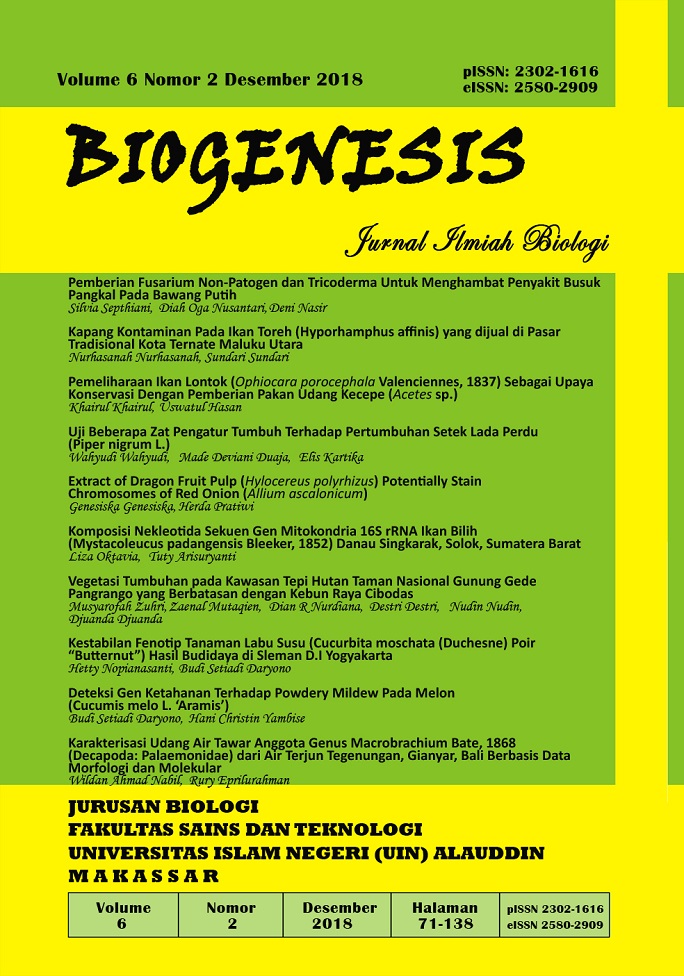Karakterisasi Udang Air Tawar Anggota Genus Macrobrachium Bate, 1868 (Decapoda: Palaemonidae) dari Air Terjun Tegenungan, Gianyar, Bali Berbasis Data Morfologi dan Molekular
Abstrak
Macrobrachium is one of prawn genera which has largest species number in family Palaemonidae, with some species of this genus being important commodity in aquaculture. Morphological characters for identification of this genus depend on environmental condition, growth phase, sex, and social dominance. This makes morphological identification on this genus quite difficult and tricky. Alternative approaches are required for better methods of Macrobrachium identification. DNA barcoding using 16S mitochondrial rRNA appears to be one promising method for Macrobrachium identification. This research aims to identify Macrobrachium from Tegenungan Waterfall using morphological and molecular analysis. Samples were taken from 4 sampling sites beneath the waterfall. All specimens were identified using several morphological identification methods. Specimen CR 07a and CR 10 were identified using molecular method. The molecular analysis utilized 16Sar (5’-CGCCTGTTTATCAAAAACAT-3’) as forward primer and 16Sbr (5’-CCGGTCTGAACTCAGAT-CACGT-3’) as reverse primer. From 11 specimens, 10 were identified as Macrobrachium. Specimen CR 07a was identified morphologically as M. horstii. According to BLAST analysis, specimen CR 10 was recognized as M. horstii with similarity up to 99% to GenBank specimens (JF310718.1 dan FM986616.1). Specimen CR 07a only reach 97% similarity to both GenBank specimens. Genetic distance analysis between specimen CR 07a and CR 10 assumed high genetic diversity, or even cryptic species indication in M. horstii population of Tegenungan Waterfall.
Referensi
Cai Y. and Ng PKL. 2001. The freshwater decapod crustaceans of Halmahera, Indonesia. J. Crustac. Biol. vol 21(3): 665-695.
Chace FA, and Bruce AJ. 1993. The Caridean Shrimps (Crustacea: Decapoda) of the Albatross Philippine Expedition, 1907-1910, Part 6: Superfamily Palaemonoidea. Washington: Smithsonian Institution Press.
Chen RT, Tsai CF, and Tzeng WN. 2009. 16S and 28S rDNA sequences in phylogenetic analyses of freshwater. Journal of Crustacean Biology. vol 29(3): 400-412. https://doi.org/10.1651/08-3069.1.
De Grave S, Cai Y, Anker A. 2008. Global diversity of shrimps (Crustacea: Decapoda: Caridea) in freshwater. Hydrobiologia. vol 595(1): 287–293. https://doi.org/10.1007/s10750-007-9024-2.
Holthuis LB. 1950. The Decapoda of the Siboga Expedition. Part X. The Palaemonidae collected by the Siboga and Snellius Expeditions with remarks on other species. I. Subfamily Palaemoninae. Siboga Expéditie. vol 39: 1-268.
Liu MY, Cai YX, Tzeng CS. 2007. Molecular Systematics of the Freshwater Prawn Genus Macrobrachium Bate, 1868 (Crustacea: Decapoda: Palaemonidae) Inferred from mtDNA Sequences, with emphasis on East Asian species. Zool. Stud. vol 46(3): 272-289.
Munasinghe D. 2010. Phylogenetic positions of some species of the genus Macrobrachium Bate, 1868 (Crustacea, Decapoda, Palaemonidae) in Sri Lanka. J. Natn. Sci. Foundation Sri Lanka. vol 38(3): 193-199.
New MB. 2002. Farming freshwater prawns. A manual for the culture of the giant river prawn (Macrobrachium rosenbergii). FAO technical paper. Rome: Food and Agriculture Organization of the United Nations. https://doi.org/10.1016/j.aquaculture.2003.08.004.
Page TJ, and Hughes JM. 2011. Neither molecular nor morphological data have all the answers; with an example from Macrobrachium (Decapoda: Palaemonidae) from Australia. Zootaxa. vol 2874: 65-68.
Salman SD, Page TJ, Naser MD, Yasser AG. 2006. The invasion of Macrobrachium nipponense (De Haan, 1849) (Caridea: Palaemonidae) into the Southern Iraqi Marshes. Aquatic Invasions. vol 1(3): 109-115. https://doi.org/10.3391/ai.2006.1.3.2.
Sharma C, Krishna G, Kumar AP, Nayak SK. 2014. Phylogeny of Macrobrachium species using mitochondrial 16s ribosomal DNA. Cell Tissue Res. vol 14(3): 4525-4529.
Short JW. 2004. A revision of Australian river prawns, Macrobrachium (Crustacea: Decapoda: Palaemonidae). Hydrobiologia. vol 525: 1-100.
Short JW. 2008. Freshwater Crustacea of the Mimika Region – Papua, Indonesia. Timika: Environmental Departement of PT Freeport Indonesia.
Short JW, and Meek P. 2000. New records of Macrobrachium (Crustacea: Decapoda: Palaemonidae) from Christmas Island, Indian Ocean. Records of the Western Australian MllsCllm. vol 20: 81–86.
Wowor D. and Choy SC. 2001. The freshwater prawns of the genus Macrobrachium Bate, 1868 (Crustacea: Decapoda: Palaemonidae) from Brunei Darussalam. Raffles Bull. Zool. vol 49(2): 269-289.
Wowor D, Muthu V, Meier R, Balke M, Cai Y, Ng PKL. 2009. Evolution of life history traits in Asian freshwater prawns of the genus Macrobrachium (Crustacea: Decapoda: Palaemonidae) based on multilocus molecular phylogenetic analysis. Molecular Phylogenetics and Evolution. vol 52(2): 340–350. https://doi.org/https://doi.org/10.1016/j.ympev.2009.01.002
##submission.copyrightStatement##
##submission.license.cc.by4.footer##COPYRIGHT AND LICENSE STATEMENT
COPYRIGHT
Biogenesis: Jurnal Ilmiah Biologi is published under the terms of the Creative Commons Attribution license. Authors hold the copyright and retain publishing rights without restriction to their work. Users may read, download, copy, distribute, and print the work in any medium, provided the original work is properly cited.
LICENSE TO PUBLISH
1. License
The use of the article will be governed by the Creative Commons Attribution license as currently displayed on http://creativecommons.org/licenses/by/4.0.
2. Author’s Warranties
The author warrants that the article is original, written by stated author/s, has not been published before, contains no unlawful statements, does not infringe the rights of others, is subject to copyright that is vested exclusively in the author and free of any third party rights, and that any necessary written permissions to quote from other sources have been obtained by the author(s).
3. User Rights
Under the Creative Commons Attribution license, the users are free to download, reuse, reprint, modify, distribute and/or copy the content for any purpose, even commercially, as long as the original authors and source are cited. No permission is required from the authors or the publishers.
4. Co-Authorship
If the article was prepared jointly with other authors, the corresponding author warrants that he/she has been authorized by all co-authors, and agrees to inform his/her co-authors of the terms of this statement.
5. Miscellaneous
Biogenesis: Jurnal Ilmiah Biologi may conform the article to a style of punctuation, spelling, capitalization, and usage that it deems appropriate. The author acknowledges that the article may be published so that it will be publicly accessible and such access will be free of charge for the readers.


